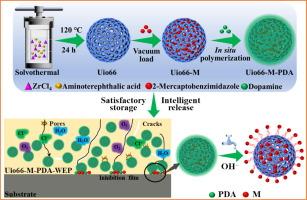聚多巴胺封装负载 2-巯基苯并咪唑复合材料的 Uio66,作为智能可控纳米贮存器,建立卓越的主动/被动防腐涂层
IF 13.2
1区 工程技术
Q1 ENGINEERING, CHEMICAL
引用次数: 0
摘要
活性保护涂层可有效减少金属腐蚀,在保护海洋工程设备方面具有巨大潜力。然而,即使在完好的涂层中,缓蚀剂也会过早地、不受控制地释放出来,从而限制了其活性保护性能。在本文中,合成了 Uio66,以负载 2-巯基苯并咪唑(M),并进一步将其与聚多巴胺(PDA)封装在一起,制成 Uio66-M-PDA 纳米材料。这种复合材料随后被用作填料,用于开发防腐水性环氧树脂(Uio66-M-PDA-WEP)。值得注意的是,PDA 具有 "水龙头 "的功能,能够有效储存和可控释放 M 分子。横截面形态表明,均匀分布的 Uio66-M-PDA 减少了内部缺陷,提高了涂层的致密性,从而进一步增强了干附着力(5.23 兆帕)和湿附着力(3.65 兆帕)。由于 Uio66、M 和 PDA 的协同作用,Uio66-M-PDA-WEP 在中性盐溶液中浸泡 60 d 后的电阻值仍为 8.3 × 109 Ω-cm2,分别是纯 WEP(6.8 × 106 Ω-cm2)、Uio66-WEP(2.5 × 107 Ω-cm2)和 Uio66-M-WEP (1.6 × 109 Ω-cm2)的 1220.6、334.7 和 5.3 倍。此外,Uio66-M-PDA-WEP 还能确保缓蚀剂的高效存储和智能释放,为金属基底提供可靠的活性保护性能。总之,这项研究成功地解决了主动/被动保护涂层中缓蚀剂不受控制和过早释放的问题,为实际应用提供了宝贵的见解。本文章由计算机程序翻译,如有差异,请以英文原文为准。

Polydopamine encapsulates Uio66 loaded with 2-mercaptobenzimidazole composite as intelligent and controllable nanoreservoirs to establish superior active/passive anticorrosion coating
Active protection coatings hold great potential for safeguarding marine engineering equipment by effectively reducing metal corrosion. However, the premature and uncontrollable release of corrosion inhibitors, even in intact coatings, limits their active protection performance. Herein, Uio66 was synthesized to load 2-mercaptobenzimidazole (M), which was further encapsulated with polydopamine (PDA) to produce a Uio66-M-PDA nanomaterial. This composite was then used as a filler to develop anticorrosion waterborne epoxy (Uio66-M-PDA-WEP). Notably, PDA functions as a “faucet”, enabling the efficient storage and controllable release of M molecules. The cross-section morphology indicates that the uniformly distributed Uio66-M-PDA reduces the internal defects and improves the compactness of the coating, which further strengthens the dry (5.23 MPa) and wet (3.65 MPa) adhesion force. Due to the synergistic effect of Uio66, M, and PDA, the resistance value of Uio66-M-PDA-WEP remains 8.3 × 109 Ω·cm2 after immersion in neutral salt solution for 60 d, which is 1220.6, 334.7, and 5.3 times higher than that of pure WEP (6.8 × 106 Ω·cm2), Uio66-WEP (2.5 × 107 Ω·cm2), and Uio66-M-WEP (1.6 × 109 Ω·cm2), respectively. Furthermore, Uio66-M-PDA-WEP ensures the efficient storage and intelligent release of corrosion inhibitors, offering reliable active protection properties for the metal substrate. In summary, this work successfully addresses the issues of uncontrolled and premature release of corrosion inhibitors in active/passive protective coatings and offers valuable insights for practical application.
求助全文
通过发布文献求助,成功后即可免费获取论文全文。
去求助
来源期刊

Chemical Engineering Journal
工程技术-工程:化工
CiteScore
21.70
自引率
9.30%
发文量
6781
审稿时长
2.4 months
期刊介绍:
The Chemical Engineering Journal is an international research journal that invites contributions of original and novel fundamental research. It aims to provide an international platform for presenting original fundamental research, interpretative reviews, and discussions on new developments in chemical engineering. The journal welcomes papers that describe novel theory and its practical application, as well as those that demonstrate the transfer of techniques from other disciplines. It also welcomes reports on carefully conducted experimental work that is soundly interpreted. The main focus of the journal is on original and rigorous research results that have broad significance. The Catalysis section within the Chemical Engineering Journal focuses specifically on Experimental and Theoretical studies in the fields of heterogeneous catalysis, molecular catalysis, and biocatalysis. These studies have industrial impact on various sectors such as chemicals, energy, materials, foods, healthcare, and environmental protection.
 求助内容:
求助内容: 应助结果提醒方式:
应助结果提醒方式:


